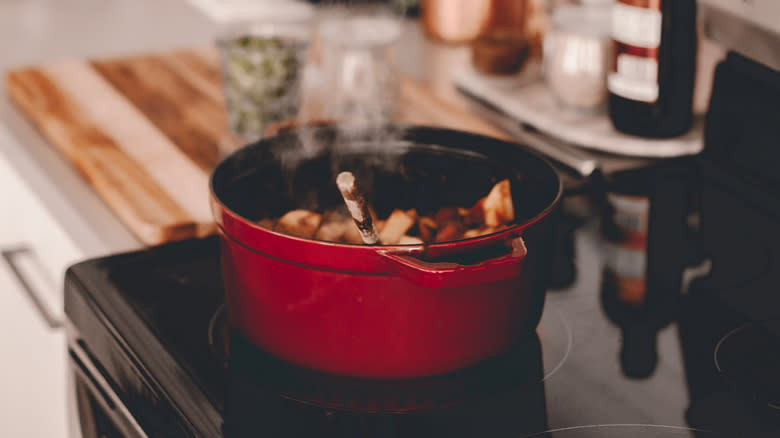The Best Time To Transfer Dutch Oven Dishes From The Stovetop To Finish Cooking

The Dutch oven is a beloved cooking vessel due to its durable and versatile nature. Dutch ovens can seamlessly transfer from stovetop to preheated ovens to make for easy and delicious one-pot meals. Knowing the best moment to transfer your Dutch oven is key to perfecting your roasted dishes. Dutch ovens are famous for their ability to maintain their temperatures throughout cooking. Using the stovetop to reach the perfect cooking temperature before transferring the dish into the oven can ensure it simmers perfectly while you kick back and relax.
The trick to knowing when to move your Dutch oven is to look at the liquid in your dish. If you are cooking vegetables or meat, make sure your liquid has reached a boiling temperature and is gently simmering before you transfer it to the oven. You're not looking for a roaring boil here, just for the water to bubble gently. Make sure your oven is preheated before you transfer your Dutch oven, and you're good to go. Once the dish has been placed in the oven, keep an eye on it for the first few minutes to ensure it keeps that simmering temperature.
Read more: The 14 Absolute Worst Mistakes You're Making With Meatloaf
Other Tips For A Successful Transfer

While your dish is baking, check in on it every now and then to make sure all of your liquid hasn't been cooked off. For most dishes, like pot roasts or chicken thighs, you'll want to save some of that reserve liquid for later, either to keep your meat moist or to turn into a flavorful sauce. If you accidentally over-reduce the cooking liquid, you will lose out on a potential flavor bomb for your meal. A small layer of liquid also prevents your meal from burning and sticking to the bottom of your Dutch oven.
To protect your Dutch oven during cooking, it's important to avoid large, rapid swings in temperature. This is why preheating your oven is crucial, but it's also important to avoid placing a cold Dutch oven right onto a hot burner and avoid adding large amounts of cold liquid to the pot when it's hot. When you prepare to move your Dutch oven from stovetop to oven, use heavily insulated and heat-resistant oven mitts or potholders. Dutch ovens hold a lot of heat, and it can be easy to underestimate them. Take it slow as you move the dish and make sure you aren't going to get burned. No matter how delicious the meal is, it's not worth risking injury for.
Read the original article on Tasting Table.

